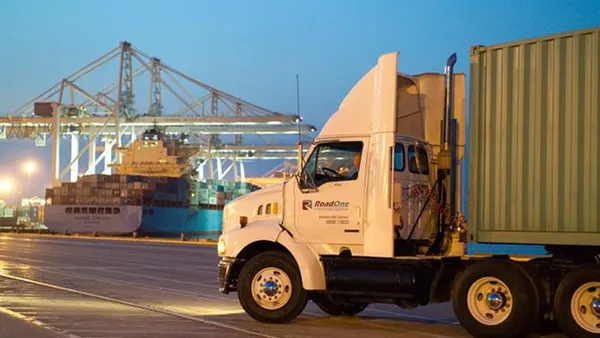Dive Brief:
- Truck movement is down in nearly all 50 states over a two-week moving average, according to data from FourKites. "We are seeing the residual effect of coming off a quarter end and the July 4th holiday," Glenn Koepke, VP of network enablement at FourKites, told Transport Dive.
- Inbound movement was particularly lower in several of the Great Lakes states. Movement in Michigan was down nearly 30% compared to its two-week moving average.
- The downturn coincides with states closing businesses again after a resurgence in COVID-19 cases. States witnessing a spike in positive cases, such as Arizona, Florida, Georgia and Texas, faced decreases in truck movement ranging from 10% to 12%.

Dive Insight:
After volume growth in May following a floor in late April, trucking movement is again trending down across the U.S. DAT data revealed similar trends in the demand slowdown. Load-to-truck ratios fell in van, flatbed and reefer the week of June 29 compared to the week before, though in all three modes the ratios were significantly higher in June compared to May. FTR and Truckstop.com reported a 16% week-over-week dip in load volume the last week of June.
The up-down, up-down again pattern of trucking movement makes the market unpredictable and uncertain, and makes planning and forecasting difficult for trucking executives. "The world is tougher and tougher to predict these days," Joe Boyle, CEO at Truce Software, told Transport Dive.
Part of the volume downturn can be attributed to seasonal trends. "Produce volumes from Mexico typically tail off quickly this time of year, and are now down 27% week over week," DAT wrote in an email. The U.S. Department of Agriculture found seasonal truckloads of produce fell 17% week over week June 28 as a result of fewer imports.
Many retailers and grocers stocked up ahead of the Fourth of July, which created a demand increase over the last two to four weeks, Koepke said. "In the weeks right after a quarter end or holiday, volume typically declines," he said.
Volume downturns are not universal across industries. FourKites' customer base has a strong presence in food and beverage, grocery, and CPG, so its data reflects movement in those industries. Agriculture, construction and manufacturing restarted in New York in mid-May, making June the "first full month where the state’s main manufacturing freight markets were fully active," Dean Croke, principal analyst for DAT, wrote in a Wednesday blog post. Month over month, dry van volumes rose 26% in June in markets in upstate New York.
Tight capacity may also contribute to the nationwide downturn of trucking movement. Boyle said trucking firms are facing the challenge of meeting demand and expanding capacity. FTR data showed an 11% decline in the supply of trucks the last week of June. DAT said capacity was tighter in the majority of southern markets, many of which were first to reopen businesses.
As a result, rates remain elevated. "The holiday might have even contributed to rate increases given decreased truck capacity in all segments," FTR wrote. Spot rates are up across modes, according to DAT, though the firm said its model shows early July as the peak for rates.

The near-term future holds continued uncertainty for the trucking market. "The market is in a significant state of flux," Koepke said. "Shipment volumes are fluctuating significantly week-to-week, [and] states and cities opening up at different paces causes imbalances in supply and demand within a market."
The upcoming back-to-school season is typically busy for supply chains, but not all school systems will move forward with normal reopening plans. New York City Mayor Bill de Blasio announced public schools will limit classroom attendance to one to three days per week, a move that would reduce the need for services such as school lunches, creating a knock-on effect on the industry transporting supplies.
Import volumes at U.S. seaports continue to decline, resulting in fewer loads for haulers. Preliminary June estimates predict a 6% year-over-year import volume decline. Imports shrank 9.3% year over year at the Port of Long Beach last month.
The National Retail Federation forecasts the lowest level of imports for peak season since 2014. Cass said it does not expect a return to pre-pandemic volumes until next year.
"There's such a lack of predictability right now," Boyle said. "The good news ... in the fleet segment is that this is essential work, so it's continued to be a very busy and demanding time."












